有点东西,template可以直接使用setup语法糖中的变量原来是因为这个
前言
我们每天写vue3代码的时候都会使用到setup语法糖,那你知道为什么setup语法糖中的顶层绑定可以在template中直接使用的呢?setup语法糖是如何编译成setup函数的呢?本文将围绕这些问题带你揭开setup语法糖的神秘面纱。注:本文中使用的vue版本为
3.4.19
。
关注公众号:【前端欧阳】,给自己一个进阶vue的机会
看个demo
看个简单的demo,代码如下:
<template>
<h1>{{ msg }}</h1>
<h2>{{ format(msg) }}</h2>
<h3>{{ title }}</h3>
<Child />
</template>
<script lang="ts" setup>
import { ref } from "vue";
import Child from "./child.vue";
import { format } from "./util.js";
const msg = ref("Hello World!");
let title;
if (msg.value) {
const innerContent = "xxx";
console.log(innerContent);
title = "111";
} else {
title = "222";
}
</script>
在上面的demo中定义了四个顶层绑定:
Child
子组件、从
util.js
文件中导入的
format
方法、使用ref定义的
msg
只读常量、使用let定义的
title
变量。并且在template中直接使用了这四个顶层绑定。
由于
innerContent
是在if语句里面的变量,不是
<script setup>
中的顶层绑定,所以在template中是不能使用
innerContent
的。
但是你有没有想过为什么
<script setup>
中的顶层绑定就能在template中使用,而像
innerContent
这种非顶层绑定就不能在template中使用呢?
我们先来看看上面的代码编译后的样子,在之前的文章中已经讲过很多次如何在浏览器中查看编译后的vue文件,这篇文章就不赘述了。编译后的代码如下:
import { defineComponent as _defineComponent } from "/node_modules/.vite/deps/vue.js?v=23bfe016";
import { ref } from "/node_modules/.vite/deps/vue.js?v=23bfe016";
import Child from "/src/components/setupDemo2/child.vue";
import { format } from "/src/components/setupDemo2/util.js";
const _sfc_main = _defineComponent({
__name: "index",
setup(__props, { expose: __expose }) {
__expose();
const msg = ref("Hello World!");
let title;
if (msg.value) {
const innerContent = "xxx";
console.log(innerContent);
title = "111";
} else {
title = "222";
}
const __returned__ = {
msg,
get title() {
return title;
},
set title(v) {
title = v;
},
Child,
get format() {
return format;
},
};
return __returned__;
},
});
function _sfc_render(_ctx, _cache, $props, $setup, $data, $options) {
// ...省略
}
_sfc_main.render = _sfc_render;
export default _sfc_main;
从上面的代码中可以看到编译后已经没有了
<script setup>
,取而代之的是一个setup函数,这也就证明了为什么说setup是一个编译时语法糖。
setup函数的参数有两个,第一个参数为组件的
props
。第二个参数为
Setup 上下文
对象,上下文对象暴露了其他一些在
setup
中可能会用到的值,比如:
expose
等。
再来看看setup函数中的内容,其实和我们的源代码差不多,只是多了一个return。
使用return会将组件中的那四个顶层绑定暴露出去,所以在template中就可以直接使用
<script setup>
中的顶层绑定。
值的一提的是在return对象中
title
变量和
format
函数有点特别。
title
、
format
这两个都是属于
访问器属性
,其他两个
msg
、
Child
属于常见的数据属性。
title
是一个
访问器属性
,同时拥有
get
和
set
,读取
title
变量时会走进
get
中,当给
title
变量赋值时会走进
set
中。
format
也是一个
访问器属性
,他只拥有
get
,调用
format
函数时会走进
get
中。由于他没有
set
,所以不能给
format
函数重新赋值。其实这个也很容易理解,因为
format
函数是从
util.js
文件中import导入的,当然不能给他重新赋值。
至于在template中是怎么拿到
setup
函数返回的对象可以看我的另外一篇文章:
Vue 3 的 setup语法糖到底是什么东西?
看到这里有的小伙伴会有疑问了,不是还有一句
import { ref } from "vue"
也是顶层绑定,为什么里面的
ref
没有在setup函数中使用return暴露出去呢?还有在return对象中是如何将
title
、
format
识别为访问器属性呢?
在接下来的文章中我会逐一解答这些问题。
compileScript
函数
在之前的
通过debug搞清楚.vue文件怎么变成.js文件
文章中已经讲过了vue的script模块中的内容是由
@vue/compiler-sfc
包中的
compileScript
函数处理的,当然你没看过那篇文章也不会影响这篇文章的阅读。
首先我们需要启动一个debug终端。这里以
vscode
举例,打开终端然后点击终端中的
+
号旁边的下拉箭头,在下拉中点击
Javascript Debug Terminal
就可以启动一个
debug
终端。

然后在
node_modules
中找到
vue/compiler-sfc
包的
compileScript
函数打上断点,
compileScript
函数位置在
/node_modules/@vue/compiler-sfc/dist/compiler-sfc.cjs.js
。接下来我们先看看简化后的
compileScript
函数源码。
简化后的
compileScript
函数
在
debug
终端上面执行
yarn dev
后在浏览器中打开对应的页面,比如:
http://localhost:5173/
。此时断点就会走到
compileScript
函数中,在我们这个场景中简化后的
compileScript
函数代码如下:
function compileScript(sfc, options) {
// ---- 第一部分 ----
// 根据<script setup>中的内容生成一个ctx上下文对象
// 在ctx上下文对象中拥有一些属性和方法
const ctx = new ScriptCompileContext(sfc, options);
const { source, filename } = sfc;
// 顶层声明的变量、函数组成的对象
const setupBindings = Object.create(null);
// script标签中的内容开始位置和结束位置
const startOffset = ctx.startOffset;
const endOffset = ctx.endOffset;
// script setup中的内容编译成的AST抽象语法树
const scriptSetupAst = ctx.scriptSetupAst;
// ---- 第二部分 ----
// 遍历<script setup>中的内容,处理里面的import语句、顶层变量、函数、类、枚举声明还有宏函数
for (const node of scriptSetupAst.body) {
if (node.type === "ImportDeclaration") {
// ...省略
}
}
for (const node of scriptSetupAst.body) {
if (
(node.type === "VariableDeclaration" ||
node.type === "FunctionDeclaration" ||
node.type === "ClassDeclaration" ||
node.type === "TSEnumDeclaration") &&
!node.declare
) {
// 顶层声明的变量、函数、类、枚举声明组成的setupBindings对象
// 给setupBindings对象赋值,{msg: 'setup-ref'}
// 顶层声明的变量组成的setupBindings对象
walkDeclaration(
"scriptSetup",
node,
setupBindings,
vueImportAliases,
hoistStatic
);
}
}
// ---- 第三部分 ----
// 移除template中的内容和script的开始标签
ctx.s.remove(0, startOffset);
// 移除style中的内容和script的结束标签
ctx.s.remove(endOffset, source.length);
// ---- 第四部分 ----
// 将<script setup>中的顶层绑定的元数据存储到ctx.bindingMetadata对象中
// 为什么要多此一举存储一个bindingMetadata对象呢?答案是setup的return的对象有时会直接返回顶层变量,有时会返回变量的get方法,有时会返回变量的get和set方法,
// 所以才需要一个bindingMetadata对象来存储这些顶层绑定的元数据。
for (const [key, { isType, imported, source: source2 }] of Object.entries(
ctx.userImports
)) {
if (isType) continue;
ctx.bindingMetadata[key] =
imported === "*" ||
(imported === "default" && source2.endsWith(".vue")) ||
source2 === "vue"
? "setup-const"
: "setup-maybe-ref";
}
for (const key in setupBindings) {
ctx.bindingMetadata[key] = setupBindings[key];
}
// 生成setup方法的args参数;
let args = `__props`;
const destructureElements =
ctx.hasDefineExposeCall || !options.inlineTemplate
? [`expose: __expose`]
: [];
if (destructureElements.length) {
args += `, { ${destructureElements.join(", ")} }`;
}
// ---- 第五部分 ----
// 根据<script setup>中的顶层绑定生成return对象中的内容
let returned;
const allBindings = {
...setupBindings,
};
for (const key in ctx.userImports) {
// 不是引入ts中的类型并且import导入的变量还需要在template中使用
if (!ctx.userImports[key].isType && ctx.userImports[key].isUsedInTemplate) {
allBindings[key] = true;
}
}
returned = `{ `;
for (const key in allBindings) {
if (
allBindings[key] === true &&
ctx.userImports[key].source !== "vue" &&
!ctx.userImports[key].source.endsWith(".vue")
) {
returned += `get ${key}() { return ${key} }, `;
} else if (ctx.bindingMetadata[key] === "setup-let") {
const setArg = key === "v" ? `_v` : `v`;
returned += `get ${key}() { return ${key} }, set ${key}(${setArg}) { ${key} = ${setArg} }, `;
} else {
returned += `${key}, `;
}
}
returned = returned.replace(/, $/, "") + ` }`;
ctx.s.appendRight(
endOffset,
`
const __returned__ = ${returned}
Object.defineProperty(__returned__, '__isScriptSetup', { enumerable: false, value: true })
return __returned__
}
`
);
// ---- 第六部分 ----
// 生成setup函数
ctx.s.prependLeft(
startOffset,
`
${genDefaultAs} /*#__PURE__*/${ctx.helper(
`defineComponent`
)}({${def}${runtimeOptions}
${hasAwait ? `async ` : ``}setup(${args}) {
${exposeCall}`
);
ctx.s.appendRight(endOffset, `})`);
// ---- 第七部分 ----
// 插入import vue语句
if (ctx.helperImports.size > 0) {
ctx.s.prepend(
`import { ${[...ctx.helperImports]
.map((h) => `${h} as _${h}`)
.join(", ")} } from 'vue'
`
);
}
return {
// ...省略
bindings: ctx.bindingMetadata,
imports: ctx.userImports,
content: ctx.s.toString(),
};
}
首先我们来看看
compileScript
函数的第一个参数
sfc
对象,在之前的文章
vue文件是如何编译为js文件
中我们已经讲过了
sfc
是一个
descriptor
对象,
descriptor
对象是由vue文件编译来的。
descriptor
对象拥有template属性、scriptSetup属性、style属性,分别对应vue文件的
<template>
模块、
<script setup>
模块、
<style>
模块。
在我们这个场景只关注
scriptSetup
属性,
sfc.scriptSetup.content
的值就是
<script setup>
模块中
code
代码字符串,
sfc.source
的值就是
vue
文件中的源代码code字符串。
sfc.scriptSetup.loc.start.offset
为
<script setup>
中内容开始位置,
sfc.scriptSetup.loc.end.offset
为
<script setup>
中内容结束位置。详情查看下图:

我们再来看
compileScript
函数中的内容,在
compileScript
函数中包含了从
<script setup>
语法糖到setup函数的完整流程。乍一看可能比较难以理解,所以我将其分为七块。
-
根据
<script setup>中的内容生成一个ctx上下文对象。 -
遍历
<script setup>中的内容,处理里面的import语句、顶层变量、顶层函数、顶层类、顶层枚举声明等。 -
移除template和style中的内容,以及script的开始标签和结束标签。
-
将
<script setup>中的顶层绑定的元数据存储到ctx.bindingMetadata对象中。 -
根据
<script setup>中的顶层绑定生成return对象。 -
生成setup函数定义
-
插入import vue语句
在接下来的文章中我将逐个分析这七块的内容。
生成ctx上下文对象
我们来看第一块的代码,如下:
// 根据<script setup>中的内容生成一个ctx上下文对象
// 在ctx上下文对象中拥有一些属性和方法
const ctx = new ScriptCompileContext(sfc, options);
const { source, filename } = sfc;
// 顶层声明的变量、函数组成的对象
const setupBindings = Object.create(null);
// script标签中的内容开始位置和结束位置
const startOffset = ctx.startOffset;
const endOffset = ctx.endOffset;
// script setup中的内容编译成的AST抽象语法树
const scriptSetupAst = ctx.scriptSetupAst;
在这一块的代码中主要做了一件事,使用
ScriptCompileContext
构造函数new了一个ctx上下文对象。在之前的
为什么defineProps宏函数不需要从vue中import导入?
文章中我们已经讲过了
ScriptCompileContext
构造函数里面的具体代码,这篇文章就不赘述了。
本文只会讲用到的
ScriptCompileContext
类中的
startOffset
、
endOffset
、
scriptSetupAst
、
userImports
、
helperImports
、
bindingMetadata
、
s
等属性。
-
startOffset、endOffset属性是在ScriptCompileContext类的constructor构造函数中赋值的。其实就是sfc.scriptSetup.loc.start.offset和sfc.scriptSetup.loc.end.offset,<script setup>中内容开始位置和<script setup>中内容结束位置,只是将这两个字段塞到ctx上下文中。 -
scriptSetupAst是在ScriptCompileContext类的constructor构造函数中赋值的,他是<script setup>模块的代码转换成的AST抽象语法树。在ScriptCompileContext类的constructor构造函数中会调用@babel/parser包的parse函数,以<script setup>中的code代码字符串为参数生成AST抽象语法树。 -
userImports在new一个ctx上下文对象时是一个空对象,用于存储import导入的顶层绑定内容。 -
helperImports同样在new一个ctx上下文对象时是一个空对象,用于存储需要从vue中import导入的函数。 -
bindingMetadata同样在new一个ctx上下文对象时是一个空对象,用于存储所有的import顶层绑定和变量顶层绑定的元数据。 -
s属性是在ScriptCompileContext类的constructor构造函数中赋值的,以vue文件中的源代码code字符串为参数new了一个MagicString对象赋值给s属性。
magic-string
是由
svelte
的作者写的一个库,用于处理字符串的
JavaScript
库。它可以让你在字符串中进行插入、删除、替换等操作,并且能够生成准确的
sourcemap
。
MagicString
对象中拥有
toString
、
remove
、
prependLeft
、
appendRight
等方法。
s.toString
用于生成返回的字符串,我们来举几个例子看看这几个方法你就明白了。
s.remove( start, end )
用于删除从开始到结束的字符串:
const s = new MagicString('hello word');
s.remove(0, 6);
s.toString(); // 'word'
s.prependLeft( index, content )
用于在指定
index
的前面插入字符串:
const s = new MagicString('hello word');
s.prependLeft(5, 'xx');
s.toString(); // 'helloxx word'
s.appendRight( index, content )
用于在指定
index
的后面插入字符串:
const s = new MagicString('hello word');
s.appendRight(5, 'xx');
s.toString(); // 'helloxx word'
除了上面说的那几个属性,在这里定义了一个
setupBindings
变量。初始值是一个空对象,用于存储顶层声明的变量、函数等。
遍历
<script setup>
body中的内容
将断点走到第二部分,代码如下:
for (const node of scriptSetupAst.body) {
if (node.type === "ImportDeclaration") {
// ...省略
}
}
for (const node of scriptSetupAst.body) {
if (
(node.type === "VariableDeclaration" ||
node.type === "FunctionDeclaration" ||
node.type === "ClassDeclaration" ||
node.type === "TSEnumDeclaration") &&
!node.declare
) {
// 顶层声明的变量、函数、类、枚举声明组成的setupBindings对象
// 给setupBindings对象赋值,{msg: 'setup-ref'}
// 顶层声明的变量组成的setupBindings对象
walkDeclaration(
"scriptSetup",
node,
setupBindings,
vueImportAliases,
hoistStatic
);
}
}
在这一部分的代码中使用for循环遍历了两次
scriptSetupAst.body
,
scriptSetupAst.body
为script中的代码对应的AST抽象语法树中body的内容,如下图:
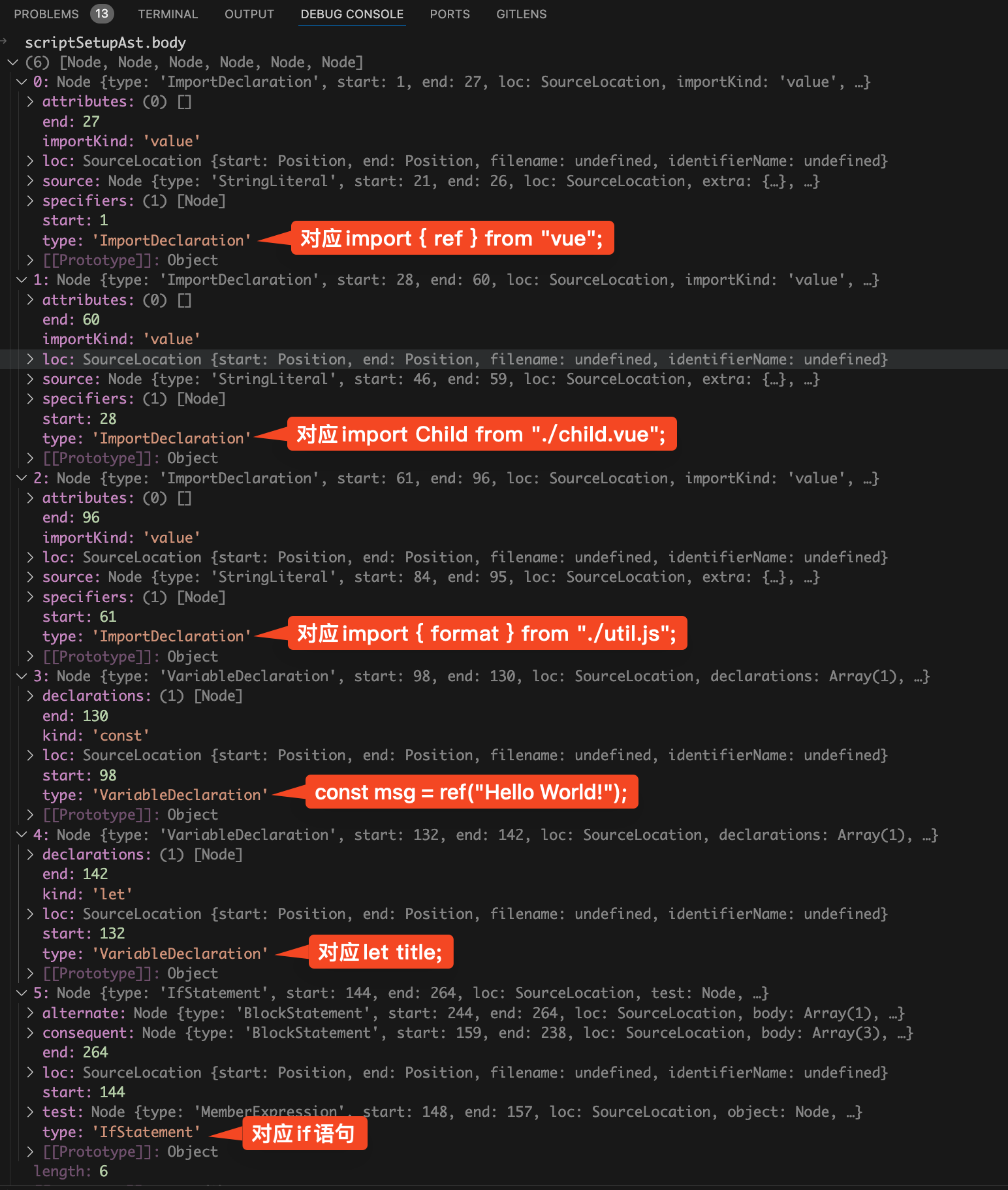
从上图中可以看到
scriptSetupAst.body
数组有6项,分别对应的是script模块中的6块代码。
第一个for循环中使用if判断
node.type === "ImportDeclaration"
,也就是判断是不是import语句。如果是import语句,那么import的内容肯定是顶层绑定,需要将import导入的内容存储到
ctx.userImports
对象中。注:后面会专门写一篇文章来讲如何收集所有的import导入。
通过这个for循环已经将所有的import导入收集到了
ctx.userImports
对象中了,在debug终端看看此时的
ctx.userImports
,如下图:

从上图中可以看到在
ctx.userImports
中收集了三个import导入,分别是
Child
组件、
format
函数、
ref
函数。
在里面有几个字段需要注意,
isUsedInTemplate
表示当前import导入的东西是不是在template中使用,如果为true那么就需要将这个import导入塞到return对象中。
isType
表示当前import导入的是不是type类型,因为在ts中是可以使用import导入type类型,很明显type类型也不需要塞到return对象中。
我们再来看第二个for循环,同样也是遍历
scriptSetupAst.body
。如果当前是变量定义、函数定义、类定义、ts枚举定义,这四种类型都属于顶层绑定(除了import导入以外就只有这四种顶层绑定了)。需要调用
walkDeclaration
函数将这四种顶层绑定收集到
setupBindings
对象中。
从前面的
scriptSetupAst.body
图中可以看到if模块的type为
IfStatement
,明显不属于上面的这四种类型,所以不会执行
walkDeclaration
函数将里面的
innerContent
变量收集起来后面再塞到return对象中。
这也就解释了为什么非顶层绑定不能在template中直接使用。
我们在debug终端来看看执行完第二个for循环后
setupBindings
对象是什么样的,如下图:

从上图中可以看到在
setupBindings
对象中收集
msg
和
title
这两个顶层变量。其中的
setup-ref
表示当前变量是一个ref定义的变量,
setup-let
表示当前变量是一个let定义的变量。
移除template模块和style模块
接着将断点走到第三部分,代码如下:
ctx.s.remove(0, startOffset);
ctx.s.remove(endOffset, source.length);
这块代码很简单,
startOffset
为
<script setup>
中的内容开始位置,
endOffset
为
<script setup>
中的内容结束位置,
ctx.s.remove
方法为删除字符串。
所以
ctx.s.remove(0, startOffset)
的作用是:移除template中的内容和script的开始标签。
ctx.s.remove(endOffset, source.length)
的作用是:移除style中的内容和script的结束标签。
我们在debug终端看看执行这两个
remove
方法之前的code代码字符串是什么样的,如下图:
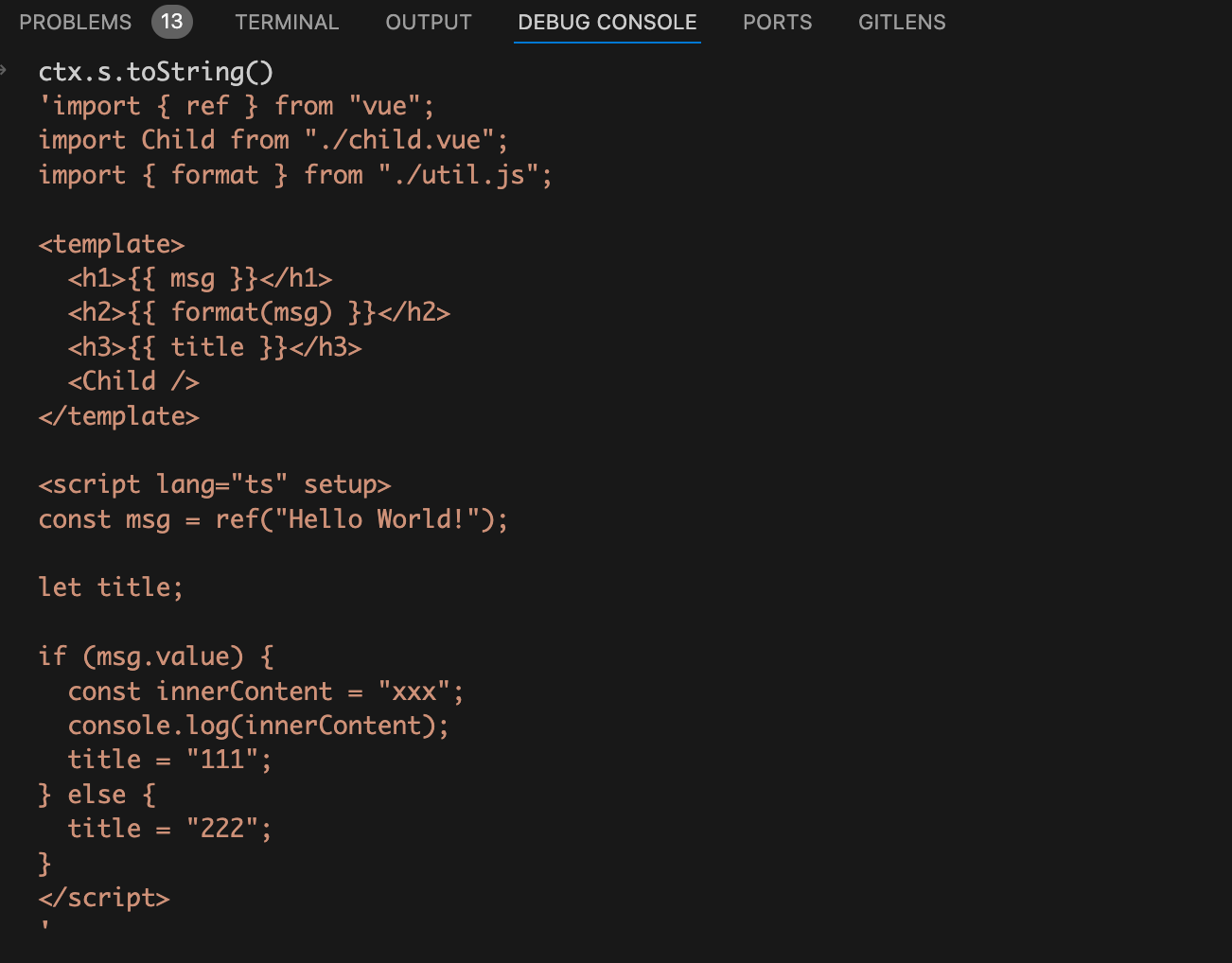
从上图中可以看到此时的code代码字符串和我们源代码差不多,唯一的区别就是那几个import导入已经被提取到script标签外面去了(这个是在前面第一个for循环处理import导入的时候处理的)。
将断点走到执行完这两个remove方法之后,在debug终端看看此时的code代码字符串,如下图:
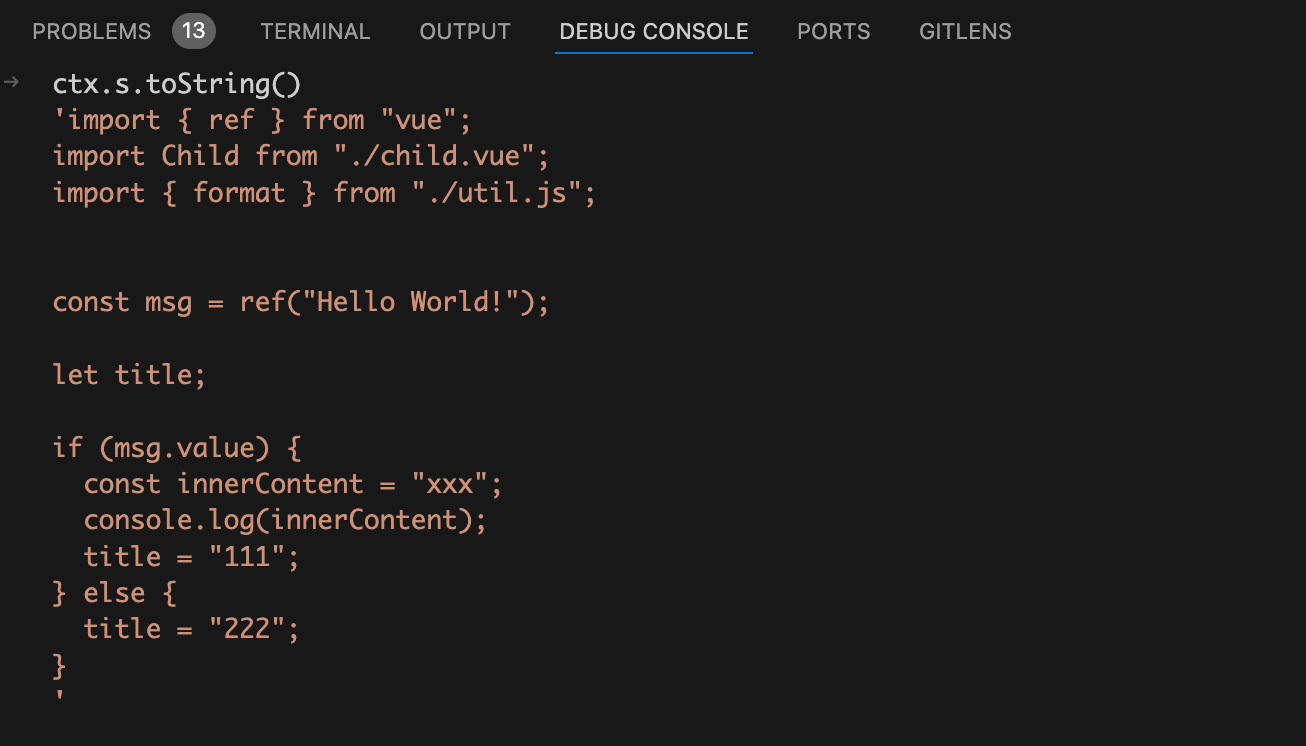
从上图中可以看到执行这两个
remove
方法后template模块、style模块(虽然本文demo中没有写style模块)、script开始标签、script结束标签都已经被删除了。唯一剩下的就是script模块中的内容,还有之前提出去的那几个import导入。
将顶层绑定的元数据存储到
ctx.bindingMetadata
接着将断点走到第四部分,代码如下:
for (const [key, { isType, imported, source: source2 }] of Object.entries(
ctx.userImports
)) {
if (isType) continue;
ctx.bindingMetadata[key] =
imported === "*" ||
(imported === "default" && source2.endsWith(".vue")) ||
source2 === "vue"
? "setup-const"
: "setup-maybe-ref";
}
for (const key in setupBindings) {
ctx.bindingMetadata[key] = setupBindings[key];
}
// 生成setup函数的args参数;
let args = `__props`;
const destructureElements =
ctx.hasDefineExposeCall || !options.inlineTemplate
? [`expose: __expose`]
: [];
if (destructureElements.length) {
args += `, { ${destructureElements.join(", ")} }`;
}
上面的代码主要分为三块,第一块为for循环遍历前面收集到的
ctx.userImports
对象。这个对象里面收集的是所有的import导入,将所有import导入塞到
ctx.bindingMetadata
对象中。
第二块也是for循环遍历前面收集的
setupBindings
对象,这个对象里面收集的是顶层声明的变量、函数、类、枚举,同样的将这些顶层绑定塞到
ctx.bindingMetadata
对象中。
为什么要多此一举存储一个
ctx.bindingMetadata
对象呢?
答案是setup的return的对象有时会直接返回顶层变量(比如demo中的
msg
常量)。有时只会返回变量的访问器属性 get(比如demo中的
format
函数)。有时会返回变量的访问器属性 get和set(比如demo中的
title
变量)。所以才需要一个
ctx.bindingMetadata
对象来存储这些顶层绑定的元数据。
将断点走到执行完这两个for循环的地方,在debug终端来看看此时收集的
ctx.bindingMetadata
对象是什么样的,如下图:

最后一块代码也很简单进行字符串拼接生成setup函数的参数,第一个参数为组件的props、第二个参数为
expose
方法组成的对象。如下图:

生成return对象
接着将断点走到第五部分,代码如下:
let returned;
const allBindings = {
...setupBindings,
};
for (const key in ctx.userImports) {
// 不是引入ts中的类型并且import导入的变量还需要在template中使用
if (!ctx.userImports[key].isType && ctx.userImports[key].isUsedInTemplate) {
allBindings[key] = true;
}
}
returned = `{ `;
for (const key in allBindings) {
if (
allBindings[key] === true &&
ctx.userImports[key].source !== "vue" &&
!ctx.userImports[key].source.endsWith(".vue")
) {
returned += `get ${key}() { return ${key} }, `;
} else if (ctx.bindingMetadata[key] === "setup-let") {
const setArg = key === "v" ? `_v` : `v`;
returned += `get ${key}() { return ${key} }, set ${key}(${setArg}) { ${key} = ${setArg} }, `;
} else {
returned += `${key}, `;
}
}
returned = returned.replace(/, $/, "") + ` }`;
ctx.s.appendRight(
endOffset,
`
const __returned__ = ${returned}
Object.defineProperty(__returned__, '__isScriptSetup', { enumerable: false, value: true })
return __returned__
}
`
);
这部分的代码看着很多,其实逻辑也非常清晰,我也将其分为三块。
在第一块中首先使用扩展运算符
...setupBindings
将
setupBindings
对象中的属性合并到
allBindings
对象中,因为
setupBindings
对象中存的顶层声明的变量、函数、类、枚举都需要被return出去。
然后遍历
ctx.userImports
对象,前面讲过了
ctx.userImports
对象中存的是所有的import导入(包括从vue中import导入ref函数)。在循环里面执行了if判断
!ctx.userImports[key].isType && ctx.userImports[key].isUsedInTemplate
,这个判断的意思是如果当前import导入的不是ts的type类型并且import导入的内容在template模版中使用了。才会去执行
allBindings[key] = true
,执行后就会将满足条件的import导入塞到
allBindings
对象中。
后面生成setup函数的return对象就是通过遍历这个
allBindings
对象实现的。这也就解释了为什么从vue中import导入的ref函数也是顶层绑定,为什么他没有被setup函数返回。因为只有在template中使用的import导入顶层绑定才会被setup函数返回。
将断点走到遍历
ctx.userImports
对象之后,在debug终端来看看此时的
allBindings
对象是什么样的,如下图:

从上图中可以看到此时的
allBindings
对象中存了四个需要return的顶层绑定。
接着就是执行for循环遍历
allBindings
对象生成return对象的字符串,这循环中有三个if判断条件。我们先来看第一个,代码如下:
if (
allBindings[key] === true &&
ctx.userImports[key].source !== "vue" &&
!ctx.userImports[key].source.endsWith(".vue")
) {
returned += `get ${key}() { return ${key} }, `;
}
if条件判断是:如果当前import导入不是从vue中,并且也不是import导入一个vue组件。那么就给return一个只拥有get的访问器属性,对应我们demo中的就是
import { format } from "./util.js"
中的
format
函数。
我们再来看第二个else if判断,代码如下:
else if (ctx.bindingMetadata[key] === "setup-let") {
const setArg = key === "v" ? `_v` : `v`;
returned += `get ${key}() { return ${key} }, set ${key}(${setArg}) { ${key} = ${setArg} }, `;
}
这个else if条件判断是:如果当前顶层绑定是一个let定义的变量。那么就给return一个同时拥有get和set的访问器属性,对应我们demo中的就是
let title"
变量。
最后就是else,代码如下:
else {
returned += `${key}, `;
}
这个else中就是普通的数据属性了,对应我们demo中的就是
msg
变量和
Child
组件。
将断点走到生成return对象之后,在debug终端来看看此时生成的return对象是什么样的,如下图:

从上图中可以看到此时已经生成了return对象啦。
前面我们只生成了return对象,但是还没将其插入到要生成的code字符串中,所以需要执行
ctx.s.appendRight
方法在末尾插入return的代码。
将断点走到执行完
ctx.s.appendRight
方法后,在debug终端来看看此时的code代码字符串是什么样的,如下图:
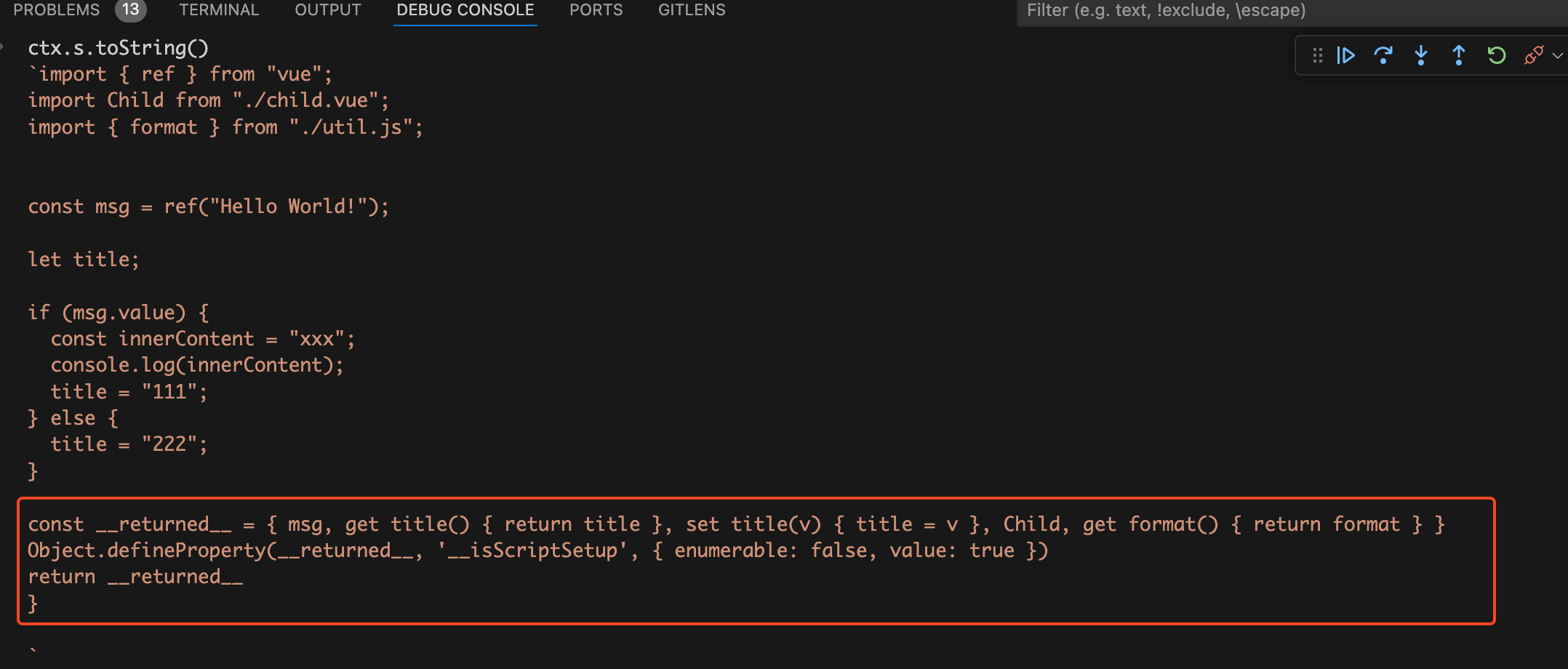
从上图中可以看到此时的code代码字符串中多了一块return的代码。
生成setup函数定义
接着将断点走到第六部分,代码如下:
ctx.s.prependLeft(
startOffset,
`
${genDefaultAs} /*#__PURE__*/${ctx.helper(
`defineComponent`
)}({${def}${runtimeOptions}
${hasAwait ? `async ` : ``}setup(${args}) {
${exposeCall}`
);
ctx.s.appendRight(endOffset, `})`);
这部分的代码很简单,调用
ctx.s.prependLeft
方法从左边插入一串代码。插入的这串代码就是简单的字符串拼接,我们在debug终端来看看要插入的代码是什么样的,如下图:

是不是觉得上面这块需要插入的代码看着很熟悉,他就是编译后的
_sfc_main
对象除去setup函数内容的部分。将断点走到
ctx.s.appendRight
方法执行之后,再来看看此时的code代码字符串是什么样的,如下图:

从上图中可以看到此时的setup函数基本已经生成完了。
插入import vue语句
上一步生成的code代码字符串其实还有一个问题,在代码中使用了
_defineComponent
函数,但是没有从任何地方去import导入。
第七块的代码就会生成缺少的import导入,代码如下:
if (ctx.helperImports.size > 0) {
ctx.s.prepend(
`import { ${[...ctx.helperImports]
.map((h) => `${h} as _${h}`)
.join(", ")} } from 'vue'
`
);
}
将断点走到
ctx.s.prepend
函数执行后,再来看看此时的code代码字符串,如下图:
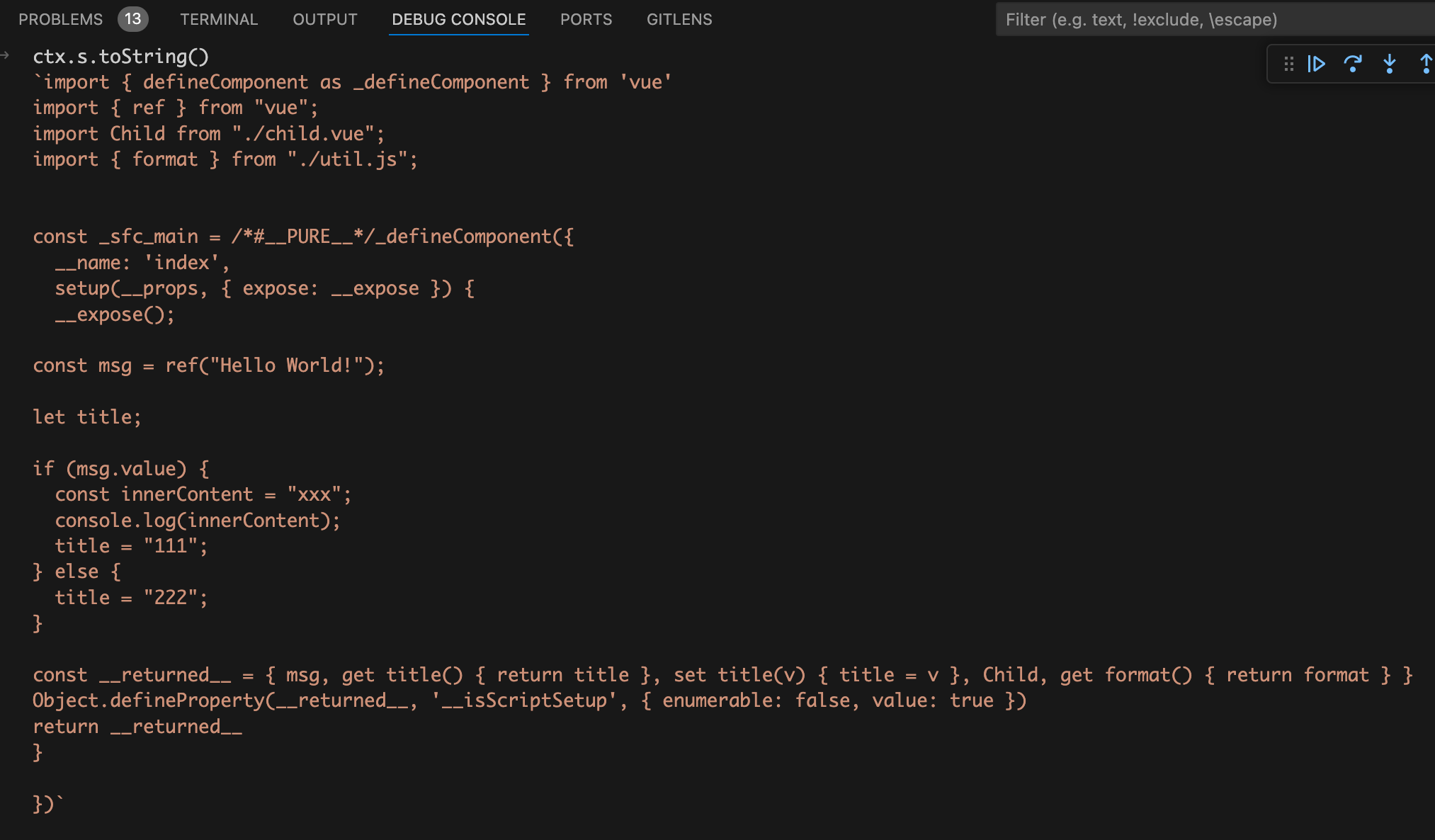
从上图中可以看到已经生成了完整的setup函数啦。
总结
整个流程图如下:
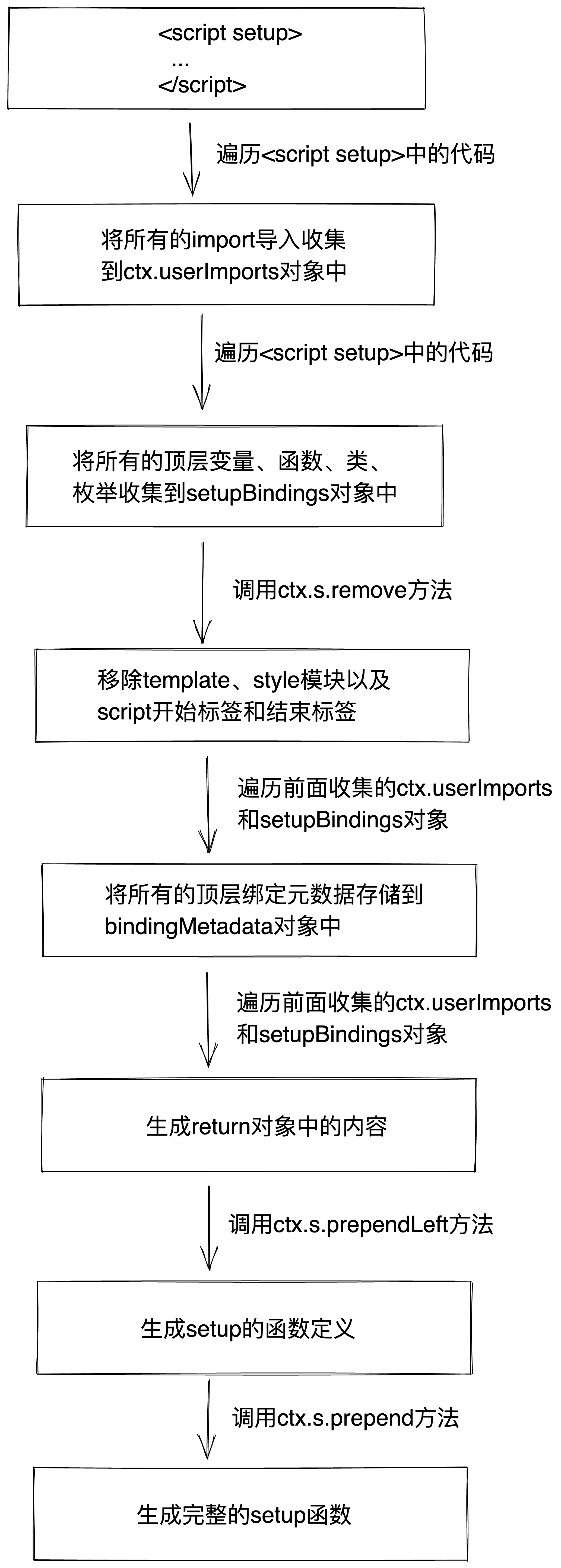
-
遍历
<script setup>中的代码将所有的import导入收集到ctx.userImports对象中。 -
遍历
<script setup>中的代码将所有的顶层变量、函数、类、枚举收集到setupBindings对象中。 -
调用
ctx.s.remove方法移除template、style模块以及script开始标签和结束标签。 -
遍历前面收集的
ctx.userImports和setupBindings对象,将所有的顶层绑定元数据存储到bindingMetadata对象中。 -
遍历前面收集的
ctx.userImports和setupBindings对象,生成return对象中的内容。在这一步的时候会将没有在template中使用的import导入给过滤掉,这也就解释了为什么从vue中导入的ref函数不包含在return对象中。 -
调用
ctx.s.prependLeft方法生成setup的函数定义。 -
调用
ctx.s.prepend方法生成完整的setup函数。
关注公众号:【前端欧阳】,给自己一个进阶vue的机会

以上就是电脑114游戏给大家带来的关于有点东西,template可以直接使用setup语法糖中的变量原来是因为这个全部内容,更多攻略请关注电脑114游戏。
电脑114游戏-好玩游戏攻略集合版权声明:以上内容作者已申请原创保护,未经允许不得转载,侵权必究!授权事宜、对本内容有异议或投诉,敬请联系网站管理员,我们将尽快回复您,谢谢合作!


